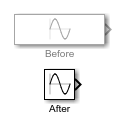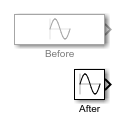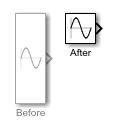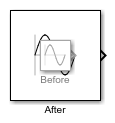Configure Model Layout Programmatically
You can programmatically arrange the blocks, signal lines, and annotations in a model, or you can specify the positions of individual blocks. You can also resize, flip, and rotate blocks. The model, library, or subsystem whose layout you want to configure must be loaded. For information about how to load models, libraries, and subsystems, see Create, Load, Open, Save, and Close Models Programmatically.
To learn how to group blocks into subsystems, see Group Blocks into Subsystems Programmatically. For information about how to change model style elements such as the colors and fonts, see Configure Model Style Elements Programmatically.
Automatically Arrange Model Diagram
To improve the arrangement of your model diagram, use the Simulink.BlockDiagram.arrangeSystem and Simulink.BlockDiagram.routeLine functions. The functions route signal lines to
avoid overlap with blocks, annotations, and other signal lines. The table shows how to take
these actions. For information about how to the handles of models and signal lines, see
Get Handles and Paths.

| Action | Command |
|---|---|
Improve layout of model diagram with the handle h. This is
the equivalent of the Auto Arrange button on the
Format tab of the Simulink® Toolstrip. |
Simulink.BlockDiagram.arrangeSystem(h) |
Improve layout of a set of signal lines. The line handles are stored in the
vector h. |
Simulink.BlockDiagram.routeLine(h) |
| When using a script to edit models, defer making changes to signal line routing until the script finishes running. | Before you run the script, run this command to defer line updates for all models. set_param(0,'LineUpdate','deferred'); When the script finishes, run this command. Simulink.BlockDiagram.routeLine('DeferredLines') |
Position Blocks and Annotations
The position of a block or annotation is determined by the Position
parameter. The parameter value is a vector with four elements that respectively define the
position left, right, top, and bottom edges of the block or annotation in the Simulink coordinate system.
p = [left right top bottom]
When a model first opens, the origin of the coordinate system is in the upper left corner of the model. The x-axis extends to the right, and the y-axis extends downward. The position of a block or annotation edge can have a positive or negative value, depending on where the edge is located relative to the origin of the coordinate system.
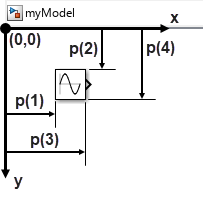
You can view and edit the value of the Position parameter of a block
or annotation using the get_param and set_param functions, respectively. The table shows examples of how to view and
change the position of a block with the handle h. You can view and change
the position of an annotation with the handle h using the same syntaxes.
For information about how to get handles, see Get Handles and Paths.
| Action | Command |
|---|---|
| Get the current position of the block. |
p = get_param(h,"Position") |
Move the block left by three times its width.
| Get the current position of the block. p = get_param(h,"Position");Get the distance you want to move the block. f = 3; width = p(3)-p(1); delta = f*width; Change the p = [p(1)-delta p(2) p(3)-delta p(4)]; Update the
set_param(h,Position=p); |
Move the block right by three times its width.
|
p = get_param(h,"Position");
f = 3;
width = p(3)-p(1);
delta = f*width;
p = [p(1)+delta p(2) p(3)+delta p(4)];
set_param(h,Position=p); |
Move the block up by three times its height.
|
p = get_param(h,"Position");
f = 3;
height = p(4)-p(2);
delta = f*height;
p = [p(1) p(2)-delta p(3) p(4)-delta];
set_param(h,Position=p); |
Move the block down by three times its height.
|
p = get_param(h,"Position");
f = 3;
height = p(4)-p(2);
delta = f*height;
p = [p(1) p(2)+delta p(3) p(4)+delta];
set_param(h,Position=p); |
You can also view and edit the position of an annotation using the name of the Simulink.Annotation object and dot notation. The table shows two examples. For
information about how to get a Simulink.annotation object, see Get Handles and Paths.
| Action | Command |
|---|---|
Get the current position of the annotation whose
Simulink.annotation object is stored in the variable named
a. |
a.Position |
Set the position of the annotation whose
|
a.Position = [50 0 134 15]; |
By changing the position of a block or annotation, you can line up blocks and
annotations. The table shows examples of how to line up two blocks with the handles
h1 and h2. In the examples, the block with the
handle h1 stays in place, and the block with the handle
h2 moves.
| Action | Command |
|---|---|
Line up the blocks horizontally at their left edge.
| Get the current positions of the blocks. p1 = get_param(h1,"Position"); p2 = get_param(h2,"Position"); Get the distance between the left edges of the two blocks. delta = p2(1)-p1(1); Change
the p2 = [p2(1)-delta p2(2) p2(3)-delta p2(4)]; Update
the set_param(h2,Position=p2); |
Line up the blocks at their horizontal middle.
|
p1 = get_param(h1,"Position"); p2 = get_param(h2,"Position"); delta = (p2(1)-p1(1)+p2(3)-p1(3))/2; p2 = [p2(1)-delta p2(2) p2(3)-delta p2(4)]; set_param(h2,Position=p2); |
Line up the blocks horizontally at their right edge.
|
p1 = get_param(h1,"Position"); p2 = get_param(h2,"Position"); delta = p2(3)-p1(3); p2 = [p2(1)-delta p2(2) p2(3)-delta p2(4)]; set_param(h2,Position=p2); |
Line up the blocks vertically at their top edge.
|
p1 = get_param(h1,"Position"); p2 = get_param(h2,"Position"); delta = p2(2)-p1(2); p2 = [p2(1) p2(2)-delta p2(3) p2(4)-delta]; set_param(h2,Position=p2); |
Line up the blocks at their vertical middle.
|
p1 = get_param(h1,"Position"); p2 = get_param(h2,"Position"); delta = (p2(2)-p1(2)+p2(4)-p1(4))/2; p2 = [p2(1) p2(2)-delta p2(3) p2(4)-delta]; set_param(h2,Position=p2); |
Line up the blocks at their bottom edge.
|
p1 = get_param(h1,"Position"); p2 = get_param(h2,"Position"); delta = p2(4)-p1(4); p2 = [p2(1) p2(2)-delta p2(3) p2(4)-delta]; set_param(h2,Position=p2); |
Line up the blocks at their center.
|
p1 = get_param(h1,"Position"); p2 = get_param(h2,"Position"); deltaH = (p2(1)-p1(1)+p2(3)-p1(3))/2; deltaV = (p2(2)-p1(2)+p2(4)-p1(4))/2; p2 = [p2(1)-deltaH p2(2)-deltaV p2(3)-deltaH p2(4)-deltaV]; set_param(h2,Position=p2); |
Resize Blocks
You can resize a block by changing the value of the Position
parameter. To change the block width, change the position of the right edge of the block
relative to the left edge of the block. To change the block height, change the position of
the bottom edge of the block relative to the top edge of the block. You can view and edit
the value of the Position parameter using the get_param and set_param functions, respectively. The
table shows examples of how to view and change the size of a block with the handle
h. For information about how to get block handles, see Get Handles and Paths.
| Action | Command |
|---|---|
| Get the current width of the block. |
p = get_param(h,"Position");
width = p(3)-p(1) |
| Get the current height of the block. |
p = get_param(h,"Position");
height = p(4)-p(2) |
Stretch the block horizontally to the left by a factor of
| Specify the factor by which you want to stretch the block. f = 3; Get the current position of the block. p = get_param(h,"Position");Get the distance by which you want to stretch the block. width = p(3)-p(1); delta = (f-1)*width; Change the p = [p(1)-delta p(2) p(3) p(4)]; Update the
set_param(h,Position=p); |
Stretch the block horizontally from its center by a factor of
|
f = 3;
p = get_param(h,"Position");
width = p(3)-p(1);
delta = ((f-1)*width)/2;
p = [p(1)-delta p(2) p(3)+delta p(4)];
set_param(h,Position=p); |
Stretch the block horizontally to the right by a factor of
|
f = 3;
p = get_param(h,"Position");
width = p(3)-p(1);
delta = (f-1)*width;
p = [p(1) p(2) p(3)+delta p(4)];
set_param(h,Position=p); |
Contract the block horizontally to the left by a factor of
|
f = 1/3;
p = get_param(h,"Position");
width = p(3)-p(1);
delta = (f-1)*width;
p = [p(1) p(2) p(3)+delta p(4)];
set_param(h,Position=p); |
Contract the block horizontally from its center by a factor of
|
f = 1/3;
p = get_param(h,"Position");
width = p(3)-p(1);
delta = ((f-1)*width)/2;
p = [p(1)-delta p(2) p(3)+delta p(4)];
set_param(h,Position=p); |
Contract the block horizontally to the right by a factor of
|
f = 1/3;
p = get_param(h,"Position");
width = p(3)-p(1);
delta = (f-1)*width;
p = [p(1)-delta p(2) p(3) p(4)];
set_param(h,Position=p); |
Stretch the block vertically upward by a factor of
|
f = 3;
p = get_param(h,"Position");
height = p(4)-p(2);
delta = (f-1)*height;
p = [p(1) p(2)-delta p(3) p(4)];
set_param(h,Position=p); |
Stretch the block vertically from its middle by a factor of
|
f = 3;
p = get_param(h,"Position");
height = p(4)-p(2);
delta = (f-1)*height/2;
p = [p(1) p(2)-delta p(3) p(4)+delta];
set_param(h,Position=p); |
Stretch the block vertically downward by a factor of
|
f = 3;
p = get_param(h,"Position");
height = p(4)-p(2);
delta = (f-1)*height;
p = [p(1) p(2) p(3) p(4)+delta];
set_param(h,Position=p); |
Contract the block vertically upward by a factor of
|
f = 1/3;
p = get_param(h,"Position");
height = p(4)-p(2);
delta = (f-1)*height;
p = [p(1) p(2)-delta p(3) p(4)];
set_param(h,Position=p); |
Contract the block vertically from its middle by a factor of
|
f = 1/3;
p = get_param(h,"Position");
height = p(4)-p(2);
delta = (f-1)*height/2;
p = [p(1) p(2)-delta p(3) p(4)+delta];
set_param(h,Position=p); |
Contract the block vertically downward by a factor of
|
f = 1/3;
p = get_param(h,"Position");
height = p(4)-p(2);
delta = (f-1)*height;
p = [p(1) p(2) p(3) p(4)+delta];
set_param(h,Position=p); |
Stretch the block horizontally and vertically from its center by a factor
of
|
f = 3;
p = get_param(h,"Position");
width = p(3)-p(1);
height = p(4)-p(2);
delta1 = (f-1)*width/2;
delta2 = (f-1)*height/2;
p = [p(1)-delta1 p(2)-delta2 p(3)+delta1 p(4)+delta2];
set_param(h,Position=p); |
Contract the block horizontally and vertically from its center by a
factor of
|
f = 1/3;
p = get_param(h,"Position");
width = p(3)-p(1);
height = p(4)-p(2);
delta1 = (f-1)*width/2;
delta2 = (f-1)*height/2;
p = [p(1)-delta1 p(2)-delta2 p(3)+delta1 p(4)+delta2];
set_param(h,Position=p); |
These blocks display a parameter value on their block icons:
When the blocks are too small to display the full parameter value, the blocks display a
placeholder letter instead, for example, -K-. To resize blocks of these
types to be large enough to display their values, use the Simulink.BlockDiagram.resizeBlocksToFitContent function. The table shows
examples of how to use the function. The function does not act on blocks in referenced
models.

| Action | Command |
|---|---|
Resize all blocks of the listed block types in a model named
|
Simulink.BlockDiagram.resizeBlocksToFitContent("myModel") |
Get the paths of all blocks of the listed block types in a model named
myModel that display placeholder letters. Do not resize the
blocks. |
blocks = Simulink.BlockDiagram.resizeBlocksToFitContent("myModel",... ReportOnly="true") |
A model named |
blocks = find_system("myModel/mySubsystem"); Simulink.BlockDiagram.resizeBlocksToFitContent("myModel",... BlockList=blocks) |
Flip Blocks
The orientation of a block is determined by the Orientation parameter
of the block. You can view and edit the value of the Orientation
parameter using the get_param and set_param functions, respectively. The table shows examples of how to flip a
block with the handle h. For information about how to get block handles,
see Get Handles and Paths.
Note
Flipping a block does not flip the block icon. The flip operation described in this section is the operation you can perform interactively using the options on the Format tab of the model window. The final location of the block label might differ between the interactive and programmatic approach.
| Action | Command |
|---|---|
| Get the current orientation of the block. |
get_param(h,"Orientation") |
Flip the block left.
|
set_param(h,Orientation="Left"); |
Flip the block right. Flipping the block right returns the block to its default orientation.
|
set_param(h,Orientation="Right"); |
Flip the block up.
|
set_param(h,Orientation="Up"); |
Flip the block down.
|
set_param(h,Orientation="Down"); |
Rotate Blocks
The orientation of a block is determined by the Orientation parameter
of the block. You can view and edit the value of the Orientation
parameter using the get_param and set_param functions, respectively. The table shows examples of how to rotate a
block with the handle h. For information about how to get block handles,
see Get Handles and Paths.
Note
Rotating a block does not rotate the block icon. The rotate operation described in this section is the same as the operation you can perform interactively using the options on the Format tab of the model window.
| Action | Command |
|---|---|
Get the current orientation of the block. |
get_param(h,"Orientation") |
Rotate the block 90 degrees clockwise.
|
set_param(h,Orientation="Down"); |
Rotate the block 180 degrees clockwise.
|
set_param(h,Orientation="Left"); |
Rotate the block 270 degrees clockwise.
|
set_param(h,Orientation="Up"); |
Return the block to its default orientation.
|
set_param(h,Orientation="Right"); |
Position, Resize, Flip, or Rotate Multiple Blocks at Once
To position, resize, flip or rotate multiple blocks at once, take the same basic
approach as for one block, but specify the blocks as a vector of handles or an array of
block paths expressed as a string array or a cell array of character vectors (strings are
recommended over character vectors). When specifying multiple blocks, the output of the
get_param function is a cell array. Adjust the commands to work with
the cell array.
For example, to stretch two blocks with the handles h1 and
h2 horizontally and vertically about their centers by a factor of
3, follow these steps.
Create a vector that stores the block handles.
h = [h1 h2];
Specify the factor by which you want to stretch the blocks.
f = 3;
Get the current positions of the blocks. The output of the
get_paramfunction is a cell array. Convert the cell array to a numerical matrix using thecell2matfunction.p = cell2mat(get_param(h,"Position"));Get the distance by which you want to stretch each block. The top row of the matrix stores the position vector of one block. The bottom row stores the position vector of the other block.
width = p(:,3)-p(:,1); height = p(:,4)-p(:,2); delta1 = (f-1)*width/2; delta2 = (f-1)*height/2;
Change the
pmatrix to reflect the new block sizes.p = [p(:,1)-delta1 p(:,2)-delta2 p(:,3)+delta1 p(:,4)+delta2];
Create a function that takes an index,
i, and resizes the block whose handle is stored in the ith row of thehvector.myFun = @(i) set_param(h(i),Position=p(i,:));
Create a vector of the indices of all rows in the
hvector.i = 1:length(h);
Run the function for all indices in the vector
iusing thearrayfunfunction.arrayfun(myFun,i);
The table shows how the commands for stretching one block horizontally and vertically by
a factor of 3 compare to the commands for stretching multiple
blocks.
| Stretch One Block | Stretch Multiple Blocks |
|---|---|
f = 3;
p = get_param(h,"Position");
width = p(3)-p(1);
height = p(4)-p(2);
delta1 = (f-1)*width/2;
delta2 = (f-1)*height/2;
p = [p(1)-delta1 p(2)-delta2 p(3)+delta1 p(4)+delta2];
set_param(h,Position=p);
|
f = 3;
p = cell2mat(get_param(h,"Position"));
width = p(:,3)-p(:,1);
height = p(:,4)-p(:,2);
delta1 = (f-1)*width/2;
delta2 = (f-1)*height/2;
p = [p(:,1)-delta1 p(:,2)-delta2 p(:,3)+delta1 p(:,4)+delta2];
myFun = @(i) set_param(h(i),Position=p(i,:));
i = 1:length(h);
arrayfun(myFun,i);
|
See Also
Simulink.BlockDiagram.arrangeSystem | Simulink.BlockDiagram.routeLine | get_param | set_param | Simulink.Annotation















